LUPANETA PACK- leuprolide acetate and norethindrone acetate kit
Lupaneta Pack by
Drug Labeling and Warnings
Lupaneta Pack by is a Prescription medication manufactured, distributed, or labeled by AbbVie Inc.. Drug facts, warnings, and ingredients follow.
Drug Details [pdf]
-
HIGHLIGHTS OF PRESCRIBING INFORMATION
These highlights do not include all the information needed to use LUPANETA PACK safely and effectively. See full prescribing information for LUPANETA PACK.
LUPANETA PACK (leuprolide acetate for depot suspension; norethindrone acetate tablets), co-packaged for intramuscular use and for oral use, respectively
Initial U.S. Approval: 2012INDICATIONS AND USAGE
LUPANETA PACK contains leuprolide acetate, a gonadotropin-releasing hormone (GnRH) agonist and norethindrone acetate, a progestin, indicated for
- Initial management of the painful symptoms of endometriosis (1)
- Management of recurrence of symptoms (1)
Limitations of Use: Initial treatment course is limited to 6 months and use is not recommended longer than a total of 12 months due to concerns about adverse impact on bone mineral density. (1, 2.1, 5.1)
DOSAGE AND ADMINISTRATION
- Leuprolide acetate for depot suspension 3.75 mg given by a healthcare provider as a single intramuscular injection every month for up to six injections (6 months of therapy) (2.1)
- Norethindrone acetate 5 mg tablets taken orally by the patient once per day for up to 6 months (2.1)
- If endometriosis symptoms recur after initial course of therapy, consider retreatment for up to another six months (2.1)
- Assess bone density before retreatment begins (2.1, 5.1)
- Reconstitute leuprolide acetate prior to use, see important administration instructions (2.3)
DOSAGE FORMS AND STRENGTHS
CONTRAINDICATIONS
- Hypersensitivity to GnRH, GnRH agonist or any of the excipients in leuprolide acetate for depot suspension or norethindrone acetate (4)
- Undiagnosed abnormal uterine bleeding (4)
- Pregnancy or suspected pregnancy (4, 8.1)
- Women who are breast-feeding (4)
- Known, suspected or history of breast or other hormone-sensitive cancer (4)
- Thrombotic or thromboembolic disorders (4)
- Liver tumors or liver disease (4)
WARNINGS AND PRECAUTIONS
- Loss of bone mineral density: do not use for more than two six-month treatment courses. (1, 2.1, 5.1)
- Exclude pregnancy before starting treatment and discontinue use if pregnancy occurs; use non-hormonal methods of contraception only. (5.2)
- Discontinue in case of sudden loss of vision or onset of proptosis, diplopia or migraine. (5.3)
- Carefully observe patients with history of depression and discontinue the drug if the depression recurs to a serious degree. (5.4)
- Assess and manage risk factors for cardiovascular disease before starting LUPANETA PACK. (5.6)
ADVERSE REACTIONS
Leuprolide acetate for depot suspension: Most common related adverse reactions (>10%) were hot flashes/sweats, headache/migraine, depression/emotional lability, nausea/vomiting, nervousness/anxiety, insomnia, pain, acne, asthenia, vaginitis, weight gain, constipation/diarrhea (6.1)
Progestins: breakthrough bleeding, spotting (6.1)
To report SUSPECTED ADVERSE REACTIONS, contact AbbVie Inc. at 1-800-633-9110 or FDA at 1-800-FDA-1088 or www.fda.gov/medwatch
USE IN SPECIFIC POPULATIONS
See 17 for PATIENT COUNSELING INFORMATION and FDA-approved patient labeling.
Revised: 6/2015
-
Table of Contents
FULL PRESCRIBING INFORMATION: CONTENTS*
1 INDICATIONS AND USAGE
2 DOSAGE AND ADMINISTRATION
2.1 Dosing Information
2.2 Different Formulations of Leuprolide Acetate
2.3 Reconstitution and Administration for Injection of Leuprolide Acetate
3 DOSAGE FORMS AND STRENGTHS
4 CONTRAINDICATIONS
5 WARNINGS AND PRECAUTIONS
5.1 Loss of Bone Mineral Density
5.2 Pregnancy Risk
5.3 Visual Abnormalities
5.4 Clinical Depression
5.5 Serious Allergic Reactions
5.6 Cardiovascular and Metabolic Disorders
5.7 Initial Flare of Symptoms
5.8 Fluid Retention
5.9 Convulsions
6 ADVERSE REACTIONS
6.1 Clinical Trials Experience
6.2 Postmarketing Experience
7 DRUG INTERACTIONS
7.1 Drug-Drug Interactions
7.2 Drug/Laboratory Test Interactions
8 USE IN SPECIFIC POPULATIONS
8.1 Pregnancy
8.3 Nursing Mothers
8.4 Pediatric Use
8.5 Geriatric Use
11 DESCRIPTION
12 CLINICAL PHARMACOLOGY
12.1 Mechanism of Action
12.2 Pharmacodynamics
12.3 Pharmacokinetics
13 NONCLINICAL TOXICOLOGY
13.1 Carcinogenesis, Mutagenesis, Impairment of Fertility
14 CLINICAL STUDIES
15 REFERENCES
16 HOW SUPPLIED/STORAGE AND HANDLING
17 PATIENT COUNSELING INFORMATION
- * Sections or subsections omitted from the full prescribing information are not listed.
-
1 INDICATIONS AND USAGE
LUPANETA PACK (leuprolide acetate for depot suspension and norethindrone acetate tablets) is indicated for initial management of the painful symptoms of endometriosis and for management of recurrence of symptoms.
Limitation of Use: Duration of use is limited due to concerns about adverse impact on bone mineral density [see Warnings and Precautions (5.1)]. The initial treatment course of LUPANETA PACK is limited to six months. A single retreatment course of not more than six months may be administered after the initial course of treatment if symptoms recur. Use of LUPANETA PACK for longer than a total of 12 months is not recommended.
-
2 DOSAGE AND ADMINISTRATION
2.1 Dosing Information
LUPANETA PACK is a co-packaging of leuprolide acetate for depot suspension for intramuscular use and norethindrone acetate tablets for oral use. Administer as follows:
- 3.75 mg of leuprolide acetate by intramuscular injection once a month for up to six injections (6 months of therapy); to be administered by a healthcare provider
- 5 mg of norethindrone acetate orally once daily for up to 6 months of therapy
The initial course of treatment with leuprolide acetate for depot suspension 3.75 mg in combination with norethindrone acetate 5 mg daily is not to exceed six months.
If the symptoms of endometriosis recur after the initial course of therapy, consider retreatment with LUPANETA PACK for up to another six months. It is recommended that bone density be assessed before retreatment begins [see Warnings and Precautions (5.1)].
Treatment beyond two six-month courses has not been studied and is not recommended due to concerns about adverse impact on bone mineral density.
2.2 Different Formulations of Leuprolide Acetate
Due to the specific release characteristics of the 1-month depot formulation, HCPs should not administer 3 doses of the 3.75 mg 1-month formulation simultaneously to mimic the pharmacological profile of the 11.25 mg 3-month formulation.
2.3 Reconstitution and Administration for Injection of Leuprolide Acetate
- Reconstitute and administer the lyophilized microspheres as a single intramuscular injection.
- Inject the suspension immediately or discard if not used within two hours, because leuprolide acetate for depot suspension does not contain a preservative.
- Visually inspect the leuprolide acetate for depot suspension powder. DO NOT USE the syringe if clumping or caking is evident. A thin layer of powder on the wall of the syringe is considered normal prior to mixing with the diluent. The diluent should appear clear.
- To prepare for injection, screw the white plunger into the end stopper until the stopper begins to turn (see Figure 1 and Figure 2).
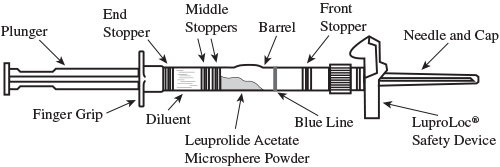
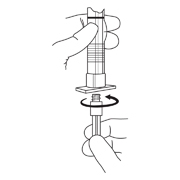
- Hold the syringe UPRIGHT. Release the diluent by SLOWLY PUSHING (6 to 8 seconds) the plunger until the first middle stopper is at the blue line in the middle of the barrel (see Figure 3).
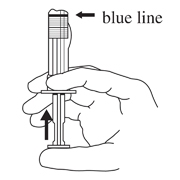
- Keep the syringe UPRIGHT. Mix the microspheres (powder) thoroughly by gently shaking the syringe until the powder forms a uniform suspension. The suspension will appear milky. If the powder adheres to the stopper or caking/clumping is present, tap the syringe with your finger to disperse. DO NOT USE if any of the powder has not gone into suspension (see Figure 4).
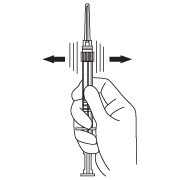
- Keep the syringe UPRIGHT. With the opposite hand pull the needle cap upward without twisting.
- Keep the syringe UPRIGHT. Advance the plunger to expel the air from the syringe. Now the syringe is ready for injection.
- After cleaning the injection site with an alcohol swab, administer the intramuscular injection by inserting the needle at a 90 degree angle into the gluteal area, anterior thigh, or deltoid (see Figure 5). Alternate injection sites.
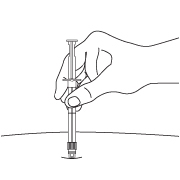
NOTE: If a blood vessel is accidentally penetrated, aspirated blood will be visible just below the luer lock (see Figure 6) and can be seen through the transparent LuproLoc safety device. If blood is present, remove the needle immediately. Do not inject the medication.
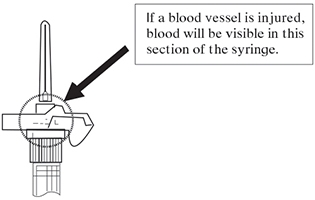
- Inject the entire contents of the syringe intramuscularly.
- Withdraw the needle. Once the syringe has been withdrawn, immediately activate the LuproLoc® safety device by pushing the arrow on the lock upward towards the needle tip with the thumb or finger, as illustrated, until the needle cover of the safety device over the needle is fully extended and a CLICK is heard or felt (see Figure 7).
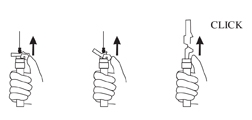
- 10. Dispose of the syringe according to local regulations/procedures [see References (15)].
-
3 DOSAGE FORMS AND STRENGTHS
LUPANETA PACK 1-month copackaged kit contains two separate components:
- Leuprolide acetate for depot suspension 3.75 mg for 1-month administration: Leuprolide acetate lyophilized powder for reconstitution with supplied diluent in a prefilled dual chamber syringe
- Norethindrone acetate 5 mg tablets: White to off-white oval, flat-faced beveled edged, uncoated debossed with ‘G with breakline’ on one side and 304 on other side
-
4 CONTRAINDICATIONS
LUPANETA PACK is contraindicated in women with the following:
- Hypersensitivity to gonadotropin-releasing hormone (GnRH), GnRH agonist analogs, any of the excipients in leuprolide acetate for depot suspension, or norethindrone acetate
- Undiagnosed abnormal uterine bleeding
- Known, suspected or planned pregnancy during the course of therapy [see Use in Specific Populations (8.1)]
- Lactating women [see Use in Specific Populations (8.3)]
- Known, suspected or history of breast cancer or other hormone-sensitive cancer
- Current or history of thrombotic or thromboembolic disorder
- Liver tumors or liver disease
-
5 WARNINGS AND PRECAUTIONS
5.1 Loss of Bone Mineral Density
Leuprolide acetate for depot suspension induces a hypoestrogenic state that results in loss of bone mineral density (BMD), some of which may not be reversible. Concurrent use of norethindrone acetate is effective in reducing the loss of BMD that occurs with leuprolide acetate [see Clinical Studies (14)]. Nonetheless, duration of use of LUPANETA PACK is limited to two six-month courses of treatment due to concerns about the adverse impact on BMD. It is recommended that BMD be assessed before retreatment. Retreatment with leuprolide acetate for depot suspension alone is not recommended.
In women with major risk factors for decreased BMD such as chronic alcohol (> 3 units per day) or tobacco use, strong family history of osteoporosis, or chronic use of drugs that can decrease BMD, such as anticonvulsants or corticosteroids, use of LUPANETA PACK may pose an additional risk, and the risks and benefits should be weighed carefully.
5.2 Pregnancy Risk
Leuprolide acetate for depot suspension may cause fetal harm if administered to a pregnant woman. Exclude pregnancy before initiating treatment with LUPANETA PACK. When used at the recommended dose and dosing interval, leuprolide acetate for depot suspension usually inhibits ovulation and stops menstruation. Contraception, however, is not ensured by taking leuprolide acetate for depot suspension. Therefore, patients should use nonhormonal methods of contraception. Advise patients to notify their healthcare provider if they believe they may be pregnant. Discontinue LUPANETA PACK if a patient becomes pregnant during treatment and inform the patient of potential risk to the fetus [see Contraindications (4) and Use in Specific Populations (8.1)].
5.3 Visual Abnormalities
Discontinue norethindrone acetate tablets in the LUPANETA PACK pending examination if there is a sudden partial or complete loss of vision or if there is sudden onset of proptosis, diplopia, or migraine. Discontinue LUPANETA PACK if examination reveals papilledema or retinal vascular lesions.
5.4 Clinical Depression
Depression may occur or worsen during treatment with LUPANETA PACK. Carefully observe patients with a history of clinical depression and discontinue LUPANETA PACK if the depression recurs to a serious degree.
5.5 Serious Allergic Reactions
In clinical trials of LUPANETA PACK, adverse events of asthma were reported in women with pre-existing histories of asthma, sinusitis and environmental or drug allergies. Symptoms consistent with an anaphylactoid or asthmatic process have been reported postmarketing.
5.6 Cardiovascular and Metabolic Disorders
Assess and manage risk factors for cardiovascular disease before starting LUPANETA PACK. Closely monitor women on norethindrone acetate who have risk factors for arterial vascular disease (e.g., hypertension, diabetes mellitus, tobacco use, hypercholesterolemia, and obesity) and/or venous thromboembolism (e.g., family history of VTE, obesity, and smoking) when using LUPANETA PACK. [see Contraindications (4)].
5.7 Initial Flare of Symptoms
Following the first dose of leuprolide acetate, sex steroids temporarily rise above baseline because of the physiologic effect of the drug. Therefore, an increase in symptoms associated with endometriosis may be observed during the initial days of therapy, but these should dissipate with continued therapy.
-
6 ADVERSE REACTIONS
6.1 Clinical Trials Experience
Because clinical trials are conducted under widely varying conditions, adverse reaction rates observed in the clinical trials of a drug cannot be directly compared to rates in the clinical trials of another drug and may not reflect the rates observed in clinical practice.
The safety of co-administering leuprolide acetate for depot suspension and norethindrone acetate was evaluated in two clinical studies in which a total of 242 women were treated for up to one year. Women were treated with monthly IM injections of leuprolide acetate 3.75 mg (13 injections) alone or monthly IM injections of leuprolide acetate 3.75 mg (13 injections) and 5 mg norethindrone acetate daily. The population age range was 17-43 years old. The majority of patients were Caucasian (87%).
One study was a controlled clinical trial in which 106 women were randomized to one year of treatment with leuprolide acetate for depot suspension alone or with leuprolide acetate for depot suspension and norethindrone acetate. The other study was an open-label single arm clinical study in 136 women of one year of treatment with leuprolide acetate for depot suspension and norethindrone acetate, with follow-up for up to 12 months after completing treatment.
Adverse Reactions (>1%) Leading to Study Discontinuation:
In the controlled study, 18% of patients treated monthly with leuprolide acetate and 18% of patients treated monthly with leuprolide acetate plus norethindrone acetate discontinued therapy due to adverse reactions, most commonly hot flashes (6%) and insomnia (4%) in the leuprolide acetate alone group and hot flashes and emotional lability (4% each) in the leuprolide acetate and norethindrone group.
In the open label study, 13% of patients treated monthly with leuprolide acetate plus norethindrone acetate discontinued therapy due to adverse reactions, most commonly depression (4%) and acne (2%).
Table 1 lists the adverse reactions observed in at least 5% of patients in any treatment group, during the first 6 months of treatment in the add-back clinical studies, in which patients were treated with monthly leuprolide acetate for depot suspension 3.75 mg with or without norethindrone acetate co-treatment. The most frequently-occurring adverse reactions observed in these studies were hot flashes and headaches.
Table 1. Adverse Reactions Occurring in the First Six Months of Treatment in ≥ 5% of Patients with Endometriosis * LA-Only = leuprolide acetate 3.75 mg
† LA/N = leuprolide acetate 3.75 mg plus norethindrone acetate 5 mgControlled Study Open Label Study LA-Only* LA/N† LA/N† N=51 N=55 N=136 Adverse Reactions N % N % N % Any Adverse Reaction 50 98 53 96 126 93 Body as a Whole Asthenia 18 18 11 Headache/Migraine 65 51 46 Injection Site Reaction 2 9 3 Pain 24 29 21 Cardiovascular System Hot flashes/Sweats 98 87 57 Digestive System Altered Bowel Function (constipation, diarrhea) 14 15 10 Changes in Appetite 4 0 6 GI Disturbance (dyspepsia, flatulence) 4 7 4 Nausea/Vomiting 25 29 13 Metabolic and Nutritional Disorders Edema 0 9 7 Weight Gain 12 13 4 Nervous System Depression/Emotional Lability 31 27 34 Dizziness/Vertigo 16 11 7 Insomnia/Sleep Disorder 31 13 15 Decreased Libido 10 4 7 Memory Disorder 6 2 4 Nervousness/Anxiety 8 4 11 Neuromuscular Disorder (leg cramps, paresthesia) 2 9 3 Skin and Appendages Androgen-Like Effects (acne, alopecia) 4 5 18 Skin/Mucous Membrane Reaction 4 9 11 Urogenital System Breast Changes/Pain/Tenderness 6 13 8 Menstrual Disorders 2 0 5 Vaginitis 20 15 8 In the controlled clinical trial, 50 of 51 (98%) patients in the leuprolide acetate alone group and 48 of 55 (87%) patients in the leuprolide acetate and norethindrone group reported experiencing hot flashes on one or more occasions during treatment. Table 2 presents hot flash data in the sixth month of treatment.
* LA-Only = leuprolide acetate 3.75 mg
† LA/N = leuprolide acetate 3.75 mg plus norethindrone acetate 5 mg
1Statistically significantly less than the LA-Only group (p<0.01)
2Number of patients assessed.Table 2. Hot Flashes in the Month Prior to the Assessment Visit (Controlled Study) Assessment Visit Treatment Group Number of Patients Reporting Hot Flashes Number of Days with Hot Flashes Maximum Number of Hot Flashes in 24 Hours N (%) N2 Mean N2 Mean Week 24 LA-Only* 32/37 86 37 19 36 5.8 LA/N† 22/38 581 38 71 38 1.91 Urinary tract infection, renal calculus, depression
Changes in Laboratory Values during Treatment:
In the two clinical trials of women with endometriosis, 4 of 191 patients receiving leuprolide acetate and norethindrone acetate for up to 12 months developed an elevated (at least twice the upper limit of normal) SGPT and 2 of 136 developed an elevated GGT. Five of the 6 increases were observed beyond 6 months of treatment. None was associated with an elevated bilirubin concentration.
Percent changes from baseline for serum lipids and percentages of patients with serum lipid values outside of the normal range in the two studies of leuprolide acetate and norethindrone acetate are summarized in the tables below. The major impact of adding norethindrone acetate to treatment with leuprolide acetate for depot suspension was a decrease in serum HDL cholesterol and an increase in the LDL/HDL ratio.
Table 3. Serum Lipids: Mean Percent Changes from Baseline Values at Treatment Week 24 * mg/dL
† ratioleuprolide acetate 3.75 mg leuprolide acetate for depot suspension 3.75 mg plus norethindrone acetate 5 mg daily Controlled Study (n=39) Controlled Study (n=41) Open Label Study (n=117) Baseline Value* Wk 24% Change Baseline Value* Wk 24% Change Baseline Value* Wk 24% Change Total Cholesterol 170.5 9.2% 179.3 0.2% 181.2 2.8% HDL Cholesterol 52.4 7.4% 51.8 -18.8% 51.0 -14.6% LDL Cholesterol 96.6 10.9% 101.5 14.1% 109.1 13.1% LDL/HDL Ratio 2.0† 5.0% 2.1† 43.4% 2.3† 39.4% Triglycerides 107.8 17.5% 130.2 9.5% 105.4 13.8% Changes from baseline tended to be greater at Week 52. After treatment, mean serum lipid levels from patients with follow up data (105 of 158 patients) returned to pretreatment values.
Table 4. Percent of Patients with Serum Lipid Values Outside of the Normal Range * Includes all patients regardless of baseline value. leuprolide acetate for depot suspension 3.75 mg plus
norethindrone acetate 5 mg dailyControlled Study
(n=41)Open Label Study
(n=117)Baseline Wk 24* Baseline Wk 24* Total Cholesterol (>240 mg/dL) 15% 20% 6% 7% HDL Cholesterol (<40 mg/dL) 15% 44% 15% 41% LDL Cholesterol (>160 mg/dL) 5% 7% 9% 11% LDL/HDL Ratio (>4.0) 2% 15% 7% 21% Triglycerides (>200 mg/dL) 12% 10% 5% 9% 6.2 Postmarketing Experience
The following adverse reactions have been identified during postapproval use of leuprolide acetate for depot suspension or norethindrone acetate. Because these reactions are reported voluntarily from a population of uncertain size, it is not always possible to reliably estimate their frequency or establish a causal relationship to drug exposure.
Leuprolide Acetate for Depot Suspension
During postmarketing surveillance with other dosage forms and in the same or different populations, the following adverse reactions were reported:
- Allergic reactions (anaphylactic, rash, urticaria, and photosensitivity reactions)
- Mood swings, including depression
- Suicidal ideation and attempt
- Symptoms consistent with an anaphylactoid or asthmatic process
- Localized reactions including induration and abscess at the site of injection
- Symptoms consistent with fibromyalgia (e.g., joint and muscle pain, headaches, sleep disorders, gastrointestinal distress, and shortness of breath), individually and collectively
Other adverse reactions reported are:
Hepato-biliary disorder - Serious liver injury
Injury, poisoning and procedural complications - Spinal fracture
Investigations - Decreased white blood count
Musculoskeletal and connective tissue disorder - Tenosynovitis-like symptoms
Nervous System disorder - Convulsion, peripheral neuropathy, paralysis
Vascular disorder - Hypotension, Hypertension
Serious venous and arterial thrombotic and thromboembolic events, including deep vein thrombosis, pulmonary embolism, myocardial infarction, stroke, and transient ischemic attack
During post-marketing surveillance, cases of pituitary apoplexy (a clinical syndrome secondary to infarction of the pituitary gland) have been reported after the administration of leuprolide acetate and other GnRH agonists. In a majority of these cases, a pituitary adenoma was diagnosed, with a majority of pituitary apoplexy cases occurring within 2 weeks of the first dose, and some within the first hour. In these cases, pituitary apoplexy has presented as sudden headache, vomiting, visual changes, ophthalmoplegia, altered mental status, and sometimes cardiovascular collapse. Immediate medical attention has been required.
-
7 DRUG INTERACTIONS
7.1 Drug-Drug Interactions
Leuprolide Acetate for Depot Suspension
No pharmacokinetic-based drug-drug interaction studies have been conducted with leuprolide acetate for depot suspension. However, drug interactions associated with cytochrome P-450 enzymes or protein binding would not be expected to occur [see Clinical Pharmacology (12.3)].
No pharmacokinetic drug interaction studies investigating any drug-drug interactions with norethindrone acetate have been conducted. Drugs or herbal products that induce or inhibit certain enzymes, including CYP3A4, may decrease or increase the serum concentrations of norethindrone.
7.2 Drug/Laboratory Test Interactions
Leuprolide Acetate for Depot Suspension
Administration of leuprolide acetate for depot suspension in therapeutic doses results in suppression of the pituitary-gonadal system. Normal function is usually restored within three months after treatment is discontinued. Therefore, diagnostic tests of pituitary gonadotropic and gonadal functions conducted during treatment and for up to three months after discontinuation of leuprolide acetate for depot suspension may be affected.
-
8 USE IN SPECIFIC POPULATIONS
8.1 Pregnancy
Pregnancy Category X – [See Contraindications (4)]
LUPANETA PACK is contraindicated in women who are or may become pregnant while receiving the drug [see Contraindications (4)]. Before starting and during treatment with leuprolide acetate for depot suspension, establish whether the patient is pregnant. Leuprolide acetate for depot suspension is not a contraceptive. In reproductively capable women, a non-hormonal method of contraception should be used [see Warnings and Precautions (5.4)].
Leuprolide acetate for depot suspension may cause fetal harm when administered to a pregnant woman.
When administered on day 6 of pregnancy at test dosages of 0.00024, 0.0024, and 0.024 mg/kg (1/300 to 1/3 of the human dose) to rabbits, leuprolide acetate for depot suspension produced a dose-related increase in major fetal abnormalities. Similar studies in rats failed to demonstrate an increase in fetal malformations. There was increased fetal mortality and decreased fetal weights with the two higher doses of leuprolide acetate for depot suspension in rabbits and with the highest dose (0.024 mg/kg) in rats.
8.3 Nursing Mothers
Do not use LUPANETA PACK in nursing mothers because the effects of leuprolide acetate for depot suspension on lactation and/or the breast-fed child have not been determined.
It is not known whether leuprolide acetate for depot suspension is excreted in human milk.
Detectable amounts of progestins have been identified in the milk of mothers receiving them [see Contraindications (4)].
-
11 DESCRIPTION
LUPANETA PACK (leuprolide acetate for depot suspension; norethindrone acetate tablets) 1-month contains one dual chamber syringe with leuprolide acetate for depot suspension 3.75 mg and norethindrone acetate tablets USP: 5 mg (bottle of 30 tablets).
Leuprolide Acetate for Depot Suspension
Leuprolide acetate for depot suspension is a synthetic nonapeptide analog of gonadotropin-releasing hormone (GnRH or LH-RH), a GnRH agonist. The chemical name is 5- oxo-L-prolyl-L-histidyl-L-tryptophyl-L-seryl-L-tyrosyl-D-leucyl-L-leucyl-L-arginyl-N-ethyl-L-prolinamide acetate (salt) with the following structural formula:

Leuprolide acetate for depot suspension 3.75 mg is available in a prefilled dual-chamber syringe containing sterile lyophilized microspheres which, when mixed with diluent, become a suspension intended as an intramuscular injection.
The front chamber of leuprolide acetate for depot suspension 3.75 mg prefilled dual-chamber syringe contains leuprolide acetate for depot suspension (3.75 mg), gelatin (0.65 mg), DL-lactic and glycolic acids copolymer (33.1 mg), and D-mannitol (6.6 mg). The second chamber of diluent contains carboxymethylcellulose sodium (5 mg), D-mannitol (50 mg), polysorbate 80 (1 mg), water for injection, USP, and glacial acetic acid, USP to control pH.
During the manufacture of leuprolide acetate for depot suspension, acetic acid is lost, leaving the peptide.
Norethindrone acetate tablets USP - 5 mg oral tablets.
Norethindrone acetate USP, (17-hydroxy-19-nor-17α-pregn-4-en-20-yn-3-one acetate), a synthetic, orally active progestin, is the acetic acid ester of norethindrone. It is a white, or creamy white, crystalline powder.
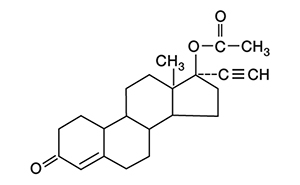
Norethindrone acetate tablets USP, 5 mg contain the following inactive ingredients: colloidal silicon dioxide, lactose monohydrate, magnesium stearate, microcrystalline cellulose and talc.
-
12 CLINICAL PHARMACOLOGY
12.1 Mechanism of Action
Leuprolide Acetate for Depot Suspension
Leuprolide acetate for depot suspension is a long-acting GnRH analog. A single injection of leuprolide acetate for depot suspension results in an initial elevation followed by a prolonged suppression of pituitary gonadotropins. Repeated dosing at quarterly intervals results in decreased secretion of gonadal steroids; consequently, tissues and functions that depend on gonadal steroids for their maintenance become quiescent. This effect is reversible on discontinuation of drug therapy.
Leuprolide acetate is not active when given orally.
Norethindrone acetate induces secretory changes in an estrogen-primed endometrium.
12.2 Pharmacodynamics
In a pharmacokinetic/pharmacodynamic study of leuprolide acetate 11.25 mg for 3-month administration in healthy female subjects (N=20), the onset of estradiol suppression was observed for individual subjects between day 4 and week 4 after dosing. By the third week following the injection, the mean estradiol concentration (8 pg/mL) was in the menopausal range. Throughout the remainder of the dosing period, mean serum estradiol levels ranged from the menopausal to the early follicular range.
Serum estradiol was suppressed to ≤20 pg/mL in all subjects within four weeks and remained suppressed (≤40 pg/mL) in 80% of subjects until the end of the 12-week dosing interval, at which time two of these subjects had a value between 40 and 50 pg/mL. Four additional subjects had at least two consecutive elevations of estradiol (range 43-240 pg/mL) levels during the 12-week dosing interval, but there was no indication of luteal function for any of the subjects during this period.
12.3 Pharmacokinetics
Leuprolide Acetate for Depot Suspension
Following a single injection of the three month formulation of leuprolide acetate for depot suspension (11.25 mg) in female subjects, a mean plasma leuprolide concentration of 36.3 ng/mL was observed at 4 hours. Leuprolide appeared to be released at a constant rate following the onset of steady-state levels during the third week after dosing and mean levels then declined gradually to near the lower limit of detection by 12 weeks. The mean (± standard deviation) leuprolide concentration from 3 to 12 weeks was 0.23 ± 0.09 ng/mL. However, intact leuprolide and an inactive major metabolite could not be distinguished by the assay which was employed in the study. The initial burst, followed by the rapid decline to a steady-state level, was similar to the release pattern seen with the monthly formulation.
Norethindrone acetate is deacetylated to norethindrone after oral administration, and the disposition of norethindrone acetate is indistinguishable from that of orally administered norethindrone. Norethindrone acetate is absorbed from norethindrone acetate tablets, with maximum plasma concentration of norethindrone generally occurring at about 2 hours post-dose (see Figure 8). The pharmacokinetic parameters of norethindrone following single oral administration of 5 mg norethindrone acetate under fasting conditions in 29 healthy female volunteers are summarized in Table 5.
Table 5. Pharmacokinetic Parameters after a Single Dose of Norethindrone Acetate in Healthy Women AUC = area under the curve,
Cmax = maximum plasma concentration,
tmax = time at maximum plasma concentration,
t1/2 = half-life,
SD = standard deviationNorethindrone Acetate (n=29) Arithmetic Mean ± SD Norethindrone AUC (0-inf) (ng/ml*h) 166.90 ± 56.28 Cmax (ng/ml) 26.19 ± 6.19 tmax (h) 1.83 ± 0.58 t1/2 (h) 8.51 ± 2.19 Figure 8. Mean Norethindrone Plasma Concentration Profile after a Single Dose of 5 mg Norethindrone Acetate Administered to 29 Healthy Female Volunteers under Fasting Conditions
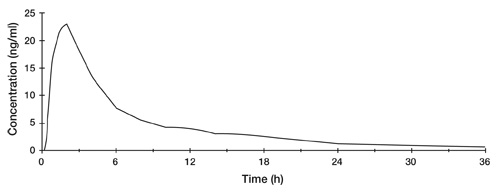
The effect of food administration on the pharmacokinetics of norethindrone acetate has not been studied.
Leuprolide Acetate for Depot Suspension
The mean steady-state volume of distribution of leuprolide following intravenous bolus administration to healthy male volunteers was 27 L. In vitro binding to human plasma proteins ranged from 43% to 49%.
Norethindrone is 36% bound to sex hormone-binding globulin (SHBG) and 61% bound to albumin. Volume of distribution of norethindrone is about 4 L/kg.
Leuprolide Acetate for Depot Suspension
In healthy male volunteers, a 1 mg bolus of leuprolide administered intravenously revealed that the mean systemic clearance was 7.6 L/h, with a terminal elimination half-life of approximately 3 hours based on a two compartment model.
In rats and dogs, administration of 14C-labeled leuprolide was shown to be metabolized to smaller inactive peptides, a pentapeptide (Metabolite I), tripeptides (Metabolites II and III) and a dipeptide (Metabolite IV). These fragments may be further catabolized.
In a pharmacokinetic/pharmacodynamic study of endometriosis patients, intramuscular 11.25 mg leuprolide acetate for depot suspension (n=19) every 12 weeks or intramuscular 3.75 mg leuprolide acetate for depot suspension (n=15) every 4 weeks was administered for 24 weeks. There was no statistically significant difference in changes of serum estradiol concentration from baseline between the 2 treatment groups.
M-I plasma concentrations measured in 5 prostate cancer patients reached maximum concentration 2 to 6 hours after dosing and were approximately 6% of the peak parent drug concentration. One week after dosing, mean plasma M-I concentrations were approximately 20% of mean leuprolide concentrations.
Norethindrone undergoes extensive biotransformation, primarily via reduction, followed by sulfate and glucuronide conjugation. The majority of metabolites in the circulation are sulfates, with glucuronides accounting for most of the urinary metabolites.
Leuprolide Acetate for Depot Suspension
Following administration of leuprolide acetate for depot suspension 3.75 mg for 1-month administration to 3 patients, less than 5% of the dose was recovered as parent and M-I metabolite in the urine.
Plasma clearance value for norethindrone is approximately 0.4 L/hr/kg. Norethindrone is excreted in both urine and feces, primarily as metabolites. The mean terminal elimination half-life of norethindrone following a single dose administration of norethindrone acetate is approximately 9 hours.
The effect of hepatic disease on the disposition of norethindrone after norethindrone acetate administration has not been evaluated. However, norethindrone acetate is contraindicated in markedly impaired liver function or liver disease [see Contraindications (4)].
The pharmacokinetics of the leuprolide acetate for depot suspension in hepatically impaired patients has not been determined.
The effect of renal disease on the disposition of norethindrone after norethindrone acetate administration has not been evaluated. In pre-menopausal women with chronic renal failure undergoing peritoneal dialysis who received multiple doses of an oral contraceptive containing ethinyl estradiol and norethindrone, plasma norethindrone concentration was unchanged compared to concentrations in pre-menopausal women with normal renal function.
The pharmacokinetics of the leuprolide acetate for depot suspension in renally impaired patients has not been determined.
The effect of race on the disposition of norethindrone after norethindrone acetate administration has not been evaluated.
Leuprolide Acetate for Depot Suspension
Leuprolide acetate for depot suspension is a peptide that is primarily degraded by peptidase and not by cytochrome P-450 enzymes as noted in specific studies, and the drug is only about 46% bound to plasma proteins, drug interactions would not be expected to occur.
-
13 NONCLINICAL TOXICOLOGY
13.1 Carcinogenesis, Mutagenesis, Impairment of Fertility
Leuprolide Acetate for Depot Suspension
A two-year carcinogenicity study was conducted in rats and mice. In rats, a dose-related increase of benign pituitary hyperplasia and benign pituitary adenomas was noted at 24 months when the drug was administered subcutaneously at high daily doses (0.6 to 4 mg/kg). There was a significant but not dose-related increase of pancreatic islet-cell adenomas in females and of testicular interstitial cell adenomas in males (highest incidence in the low dose group). In mice, no leuprolide acetate-induced tumors or pituitary abnormalities were observed at a dose as high as 60 mg/kg for two years. Patients have been treated with leuprolide acetate for up to three years with doses as high as 10 mg/day and for two years with doses as high as 20 mg/day without demonstrable pituitary abnormalities.
Mutagenicity studies have been performed with leuprolide acetate using bacterial and mammalian systems. These studies provided no evidence of a mutagenic potential.
Clinical and pharmacologic studies in adults (>18 years) with leuprolide acetate and similar analogs have shown reversibility of fertility suppression when the drug is discontinued after continuous administration for periods of up to 24 weeks. Although no clinical studies have been completed in children to assess the full reversibility of fertility suppression, animal studies (prepubertal and adult rats and monkeys) with leuprolide acetate and other GnRH analogs have shown functional recovery.
-
14 CLINICAL STUDIES
Leuprolide Acetate for Depot Suspension
Initial endometriosis efficacy data for leuprolide acetate for depot suspension were based on the 3.75 mg dose administered once monthly.
A pharmacokinetic/pharmacodynamic study in 41 women that included both the 3.75 mg dose administered once monthly and the 11.25 mg dose administered once every three months did not reveal clinically significant differences in terms of efficacy in reducing painful symptoms of endometriosis or magnitude of the decrease in bone mineral density (BMD) associated with use of leuprolide acetate.
Leuprolide Acetate for Depot Suspension Plus Norethindrone Acetate
Two clinical studies with treatment duration of 12 months were conducted to evaluate the effect of coadministration of leuprolide acetate for depot suspension and norethindrone acetate on the loss of bone mineral density (BMD) associated with leuprolide acetate for depot suspension and on the efficacy of leuprolide acetate for depot suspension in relieving symptoms of endometriosis. (All patients in these studies received calcium supplementation with 1000 mg elemental calcium). A total of 242 women were treated with monthly administration of leuprolide acetate 3.75 mg (13 injections) and with 5 mg norethindrone acetate taken daily. The population age range was 17-43 years old. The majority of patients were Caucasian (87%).
One coadministration study was a controlled, randomized and double-blind study included 51 women treated monthly with leuprolide acetate for depot suspension alone and 55 women treated monthly with leuprolide acetate for depot suspension plus norethindrone acetate daily. Women in this trial were followed for up to 24 months after completing one year of treatment. The other study was an open-label single arm clinical study in 136 women of one year of treatment with leuprolide acetate for depot suspension and norethindrone acetate, with follow-up for up to 12 months after completing treatment.
The second study was an open label, single arm study in which 136 women were treated monthly with leuprolide acetate for depot suspension plus norethindrone acetate daily, with follow-up for up to 12 months after completing treatment.
The assessment of efficacy was based on the investigator’s or the patient’s monthly assessment of five signs or symptoms of endometriosis (dysmenorrhea, pelvic pain, deep dyspareunia, pelvic tenderness and pelvic induration).
Table 6 below provides detailed efficacy data regarding relief of symptoms of endometriosis based on the two studies of coadministration of leuprolide acetate and norethindrone acetate.
* LA = leuprolide acetate 3.75 mg
† LA/N = leuprolide acetate 3.75 mg plus norethindrone acetate 5 mg
1 Number of patients that were included in the assessment
2 Percentage of patients with the symptom/sign
3 Value description: 1=none; 2= mild; 3= moderate; 4= severeTable 6. Percentages of Patients with Symptoms of Endometriosis and Mean Clinical Severity Scores Percent of Patients with Symptom Clinical Pain Severity Score Baseline Final Baseline Final Variable Study Group N1 (%)2 (%) N1 Value3 Change Dysmenorrhea Controlled Study LA* 51 (100) (4) 50 3.2 -2.0 LA/N† 55 (100) (4) 54 3.1 -2.0 Open Label Study LA/N 136 (99) (9) 134 3.3 -2.1 Pelvic Pain Controlled Study LA 51 (100) (66) 50 2.9 -1.1 LA/N 55 (96) (56) 54 3.1 -1.1 Open Label Study LA/N 136 (99) (63) 134 3.2 -1.2 Deep Dyspareunia Controlled Study LA 42 (83) (37) 25 2.4 -1.0 LA/N 43 (84) (45) 30 2.7 -0.8 Open Label Study LA/N 102 (91) (53) 94 2.7 -1.0 Pelvic Tenderness Controlled Study LA 51 (94) (34) 50 2.5 -1.0 LA/N 54 (91) (34) 52 2.6 -0.9 Open Label Study LA/N 136 (99) (39) 134 2.9 -1.4 Pelvic Induration Controlled Study LA 51 (51) (12) 50 1.9 -0.4 LA/N 54 (46) (17) 52 1.6 -0.4 Open Label Study LA/N 136 (75) (21) 134 2.2 -0.9 Suppression of menses (menses was defined as three or more consecutive days of menstrual bleeding) was maintained throughout treatment in 84% and 73% of patients receiving leuprolide acetate and norethindrone acetate, in the controlled study and open label study, respectively. The median time for menses resumption after treatment with leuprolide acetate and norethindrone acetate was 8 weeks.
The effect of leuprolide acetate for depot suspension and norethindrone acetate on bone mineral density was evaluated by dual energy x-ray absorptiometry (DXA) scan in the two clinical trials. For the open-label study, success in mitigating BMD loss was defined as the lower bound of the 95% confidence interval around the change from baseline at one year of treatment not to exceed –2.2%. The bone mineral density data of the lumbar spine from these two studies are presented in Table 7.
* Includes on-treatment measurements that fell within 2-252 days after the first day of treatment.
† Includes on-treatment measurements >252 days after the first day of treatment.
# 95% CI: 95% Confidence IntervalTable 7. Mean Percent Change from Baseline in BMD of Lumbar Spine leuprolide acetate for depot suspension 3.75 mg leuprolide acetate for depot suspension 3.75 mg plus norethindrone acetate 5 mg daily Controlled Study Controlled Study Open Label Study N Change
(Mean, 95% CI)#N Change
(Mean, 95% CI)#N Change
(Mean, 95% CI)#Week 24* 41 -3.2% (-3.8, -2.6) 42 -0.3% (-0.8, 0.3) 115 -0.2% (-0.6, 0.2) Week 52† 29 -6.3% (-7.1, -5.4) 32 -1.0% (-1.9, -0.1) 84 -1.1% (-1.6, -0.5) The change in BMD following discontinuation of treatment is shown in Table 8.
Table 8. Mean Percent Change from Baseline in BMD of Lumbar Spine in Post-Treatment
Follow-up PeriodPost Treatment Measurement Controlled Study Open Label Study LA-Only LA/N LA/N N Mean % Change 95% CI (%) N Mean % Change 95% CI (%) N Mean % Change 95% CI (%)2 Month 8 19 -3.3 (-4.9, -1.8) 23 -0.9 (-2.1, 0.4) 89 -0.6 (-1.2, 0.0) Month 12 16 -2.2 (-3.3, -1.1) 12 -0.7 (-2.1, 0.6) 65 0.1 (-0.6, 0.7) 1 Patients with post treatment measurements
2 95% CI (2-sided) of percent change in BMD values from baselineThese clinical studies demonstrated that coadministration of leuprolide acetate and norethindrone acetate 5 mg daily is effective in significantly reducing the loss of bone mineral density that occurs with leuprolide acetate for depot suspension treatment, and in relieving symptoms of endometriosis.
-
15 REFERENCES
Leuprolide Acetate for Depot Suspension
- NIOSH Alert: Preventing occupational exposures to antineoplastic and other hazardous drugs in healthcare settings. 2004. U.S. Department of Health and Human Services, Public Health Service, Centers for Disease Control and Prevention, National Institute for Occupational Safety and Health, DHHS (NIOSH) Publication No. 2004-165.
- OSHA Technical Manual, TED 1-0.15A, Section VI: Chapter 2. Controlling Occupational Exposure to Hazardous Drugs. OSHA, 1999. http://www.osha.gov/dts/osta/otm/otm_vi/otm_vi_2.html
- American Society of Health-System Pharmacists. ASHP guidelines on handling hazardous drugs. Am J Health-Syst Pharm. 2006; 63; 1172-1193.
- Polovich, M., White, J.M., & Kelleher, L.O. (eds.) 2005. Chemotherapy and biotherapy guidelines and recommendations for practice (2nd. Ed.) Pittsburgh, PA: Oncology Nursing Society.
-
16 HOW SUPPLIED/STORAGE AND HANDLING
LUPANETA PACK for 1-month copackaged kit (NDC: 0074-1052-05) is available in
cartons containing: leuprolide acetate for depot suspension 3.75 mg for 1-month
administration Kit (NDC: 0074-3641-04)
norethindrone acetate 5 mg tablets; 30 count bottle (NDC: 0074-1049-02)
- Leuprolide acetate for depot suspension 3.75 mg for 1-month administration kit contains:
- one prefilled dual-chamber syringe
- one plunger
- two alcohol swab
Each syringe contains sterile lyophilized microspheres of leuprolide acetate incorporated in a biodegradable copolymer of lactic and glycolic acids. When mixed with diluent, leuprolide acetate for depot suspension 3.75 mg for 1-month administration is administered as a single intramuscular injection.
- Norethindrone acetate 5 mg 30 count bottle
White to off-white oval, flat faced beveled edged, uncoated tablets debossed with ‘G with breakline’ on one side and 304 on other side.
Store at 25°C (77°F); excursions permitted to 15 to 30°C (59 to 86°F) [See USP Controlled Room Temperature]
- Leuprolide acetate for depot suspension 3.75 mg for 1-month administration kit contains:
-
17 PATIENT COUNSELING INFORMATION
See FDA-approved patient labeling (Patient Information)
Counsel patients about the Warnings and Precautions for LUPANETA PACK, including:
- Do not use this drug if they have experienced an allergic reaction to GnRH agonists or progestins
- Do not use this drug if they are pregnant or planning a pregnancy, suspect they may be pregnant, or are breastfeeding
- Risk of loss of bone mineral density and limitation of treatment to two six-month courses of treatment
- Risk to an exposed fetus and need to use nonhormonal contraception
- Discontinue norethindrone if they develop sudden loss of vision, double vision or sudden migraine
- The possibility of development or worsening of depression during treatment with leuprolide acetate for depot suspension
- Need for close monitoring if they have cardiovascular risk factors, or conditions like epilepsy, migraine or renal dysfunction
- Notify their healthcare provider if they develop new or worsened symptoms after beginning treatment
-
PATIENT PACKAGE INSERT
LUPANETA PACK® (loo-pan-e-tә pæk)
(leuprolide acetate for depot suspension and
norethindrone acetate tablets)Read this Patient Information before you start taking LUPANETA PACK and each time you get a refill. There may be new information. This information does not take the place of talking with your doctor about your medical condition or your treatment.
LUPANETA PACK contains 2 different prescription medicines:
- leuprolide acetate for depot suspension is a medicine injected into your muscle and used to treat pain due to endometriosis.
- norethindrone acetate tablets is a medicine taken by mouth and used to help lower the side effect of bone thinning that is caused by leuprolide acetate for depot suspension.
LUPANETA PACK should not be used longer than 6 months at a time after you first start treatment for your endometriosis symptoms. LUPANETA PACK should not be used for more than a total of 12 months during your treatment.
It is not known if LUPANETA PACK is safe and effective in children under 18 years of age.
Who should not take LUPANETA PACK?
Do not take LUPANETA PACK if you:
- have had an allergic reaction to medicines like leuprolide acetate for depot suspension or norethindrone acetate tablets. See the end of this leaflet for a complete list of ingredients in LUPANETA PACK.
- have uterine bleeding for which a cause has not been found.
- are pregnant or may be pregnant. LUPANETA PACK may harm your unborn baby.
- are breast-feeding or plan to breast-feed. It is not known if LUPANETA PACK passes into your breast milk.
- had or have breast cancer or other cancers that are sensitive to hormones.
- have problems with blood clots, a stroke or a heart attack.
- have liver problems.
What should I tell my doctor before taking LUPANETA PACK?
Before you take LUPANETA PACK, tell your doctor if you:
drink alcohol smoke have a family history of bone loss (osteoporosis) have depression have high cholesterol have had blood clots, a stroke or a heart attack have migraine headaches have diabetes have epilepsy have kidney problems Tell your doctor about all the medicines you take, including prescription and non-prescription medicines, vitamins, and herbal supplements.
Especially tell your doctor if you take anticonvulsant (seizure) or corticosteroid medicines.
Ask your doctor for a list of these medicines if you are not sure.
Know the medicines you take. Keep a list of them to show your doctor and pharmacist when you get a new medicine.
How should I take LUPANETA PACK?
- Leuprolide acetate for depot suspension for 1 month administration is injected into your muscle 1 time every month by a healthcare professional in your doctor’s office.
- Take norethindrone acetate tablets exactly as your doctor tells you to take them. Take 1 norethindrone acetate tablet by mouth every day for 1 month after you receive your injection.
- Talk to your doctor about the birth control method that is right for you before you start taking LUPANETA PACK. You will need to use a form of birth control that does not contain hormones, such as:
- a diaphragm with spermicide
- condoms with spermicide
- a copper IUD
- If you become pregnant while taking LUPANETA PACK, stop taking the norethindrone acetate tablets and call your doctor right away.
How well does LUPANETA PACK work?
LUPANETA PACK is used to treat pain due to endometriosis. The pain from endometriosis can happen when you have your period, during other times of the month, or during intercourse (sex). Most women feel some relief from their endometriosis pain after taking both drugs in LUPANETA PACK.
The tablets in LUPANETA PACK help lower the side effect of bone thinning that is caused by leuprolide acetate for depot suspension. Women taking both drugs in LUPANETA PACK lost an average of 1% of their bone density after about 1 year of treatment. Women regained some of their bone density about 1 year after they stopped treatment with LUPANETA PACK.
What are the possible side effects of LUPANETA PACK?
LUPANETA PACK may cause serious side effects, including:
- bone thinning (decreased bone mineral density)
- harm to your unborn baby
- vision problems. Call your doctor right away if you have sudden loss of vision, double vision, bulging eyes, or migraine headaches.
- depression or worsening depression
-
allergic reactions. Get medical help right away if you have any of these symptoms of a serious allergic reaction:
- swelling of your face, lips, mouth, or tongue
- trouble breathing
- wheezing
- severe itching
- skin rash, redness, or swelling
- dizziness or fainting
- fast heartbeat or pounding in your chest (tachycardia)
- sweating
- worsening endometriosis symptoms when you start taking LUPANETA PACK
- swelling (fluid retention)
The most common side effects of LUPANETA PACK include:
- hot flashes and sweats
- headaches or migraine headaches
- depression and mood swings
- nausea and vomiting
- problems sleeping
- nervousness or feeling anxious
- pain
- acne
- weakness
- vaginal infection or inflammation
- weight gain
- constipation or diarrhea
Tell your doctor if you have any side effect that bothers you or that does not go away.
These are not all the possible side effects of LUPANETA PACK. For more information, ask your doctor or pharmacist.
Call your doctor for medical advice about side effects. You may report side effects to FDA at 1-800-FDA-1088.
How should I store norethindrone acetate tablets in the LUPANETA PACK?
- Store norethindrone acetate tablets at room temperature between 68°F to 77°F (20°C to 25°C).
Keep LUPANETA PACK and all medicines out of the reach of children.
General information about the safe and effective use of LUPANETA PACK.
Medicines are sometimes prescribed for purposes other than those listed in a Patient Information leaflet. Do not use LUPANETA PACK for a condition for which it was not prescribed. Do not give LUPANETA PACK to other people, even if they have the same symptoms that you have. It may harm them.
This Patient Information leaflet summarizes the most important information about LUPANETA PACK. If you would like more information, talk with your doctor. You can ask your pharmacist or doctor for information about LUPANETA PACK that is written for health professionals.
For more information, go to www.lupanetapack.com or call 1-800-633-9110.
What are the ingredients in LUPANETA PACK?
leuprolide acetate for depot suspension:
Active Ingredients: leuprolide acetate for depot suspension
Inactive Ingredients: gelatin, DL-lactic and glycolic acids copolymer, D-mannitol,
carboxymethylcellulose sodium, polysorbate 80, water for injection, USP,
and glacial acetic acid, USP to control pH.norethindrone acetate tablets:
Active Ingredients: norethindrone acetate USP
Inactive Ingredients: colloidal silicon dioxide, lactose monohydrate,
magnesium stearate, microcrystalline cellulose and talc.This Patient Information has been approved by the U.S. Food and Drug Administration.
Leuprolide Acetate for Depot Suspension:
Manufactured for
AbbVie Inc.
North Chicago, IL 60064By Takeda Pharmaceutical Company Limited
Osaka, Japan 540-8645Norethindrone acetate:
Manufactured for
AbbVie Inc.
North Chicago, IL 60064By Glenmark Pharmaceuticals Ltd.
Colvale-Bardez, Goa
403 513, India -
PRINCIPAL DISPLAY PANEL
NDC: 0074-1052-05
leuprolide acetate for depot suspension, 3.75 mg for intramuscular injection only and norethindrone acetate tablets, 5 mg for oral administration
1 Kit Lupron Depot 1-month 3.75 mg, NDC: 0074-3641-04
Each Lupron Depot 1-month 3.75 mg Kit contains:
One pre-filled dual-chamber syringe containing needle with LuproLoc safety device One plunger Two alcohol swabs.
The front chamber of the syringe contains:
leuprolide acetate 3.75 mg purified gelatin 0.65 mg DL-lactic and glycolic acids copolymer 33.1 mg D-mannitol 6.6 mg.
D-mannitol 50 mg carboxymethylcellulose sodium 5 mg polysorbate 80 1 mg water for injection USP and glacial acetic acid USP to control pH.
Do not remove from clamshell until ready to use.
Usual dose: After mixing immediately administer entire contents of syringe by intramuscular injection once a month under physician’s supervision.
See package insert for full prescribing information.
If removed from this Kit carton, Store at 25°C (77°F). Excursions permitted to 15-30°C (59-86°F)
Only activate safety Device Post-Injection
Not made with natural rubber latex.
1 Bottle- Norethindrone Acetate Tablets USP, 5 mg 30 Tablets. NDC: 0074-1049-02
Usual dose: 5 mg (one tablet) orally once daily for 1 month. See package insert for full prescribing information.
If removed from this Kit carton, Store at 20-25°C (68-77°F).
Dispense in well closed containers
For 1 MONTH ADMINISTRATION FOR ADULT USE ONLY
Store at 25°C (77°F), excursion permitted to 15°-30°C (59°-86°F) [See USP Controlled Room Temperature].
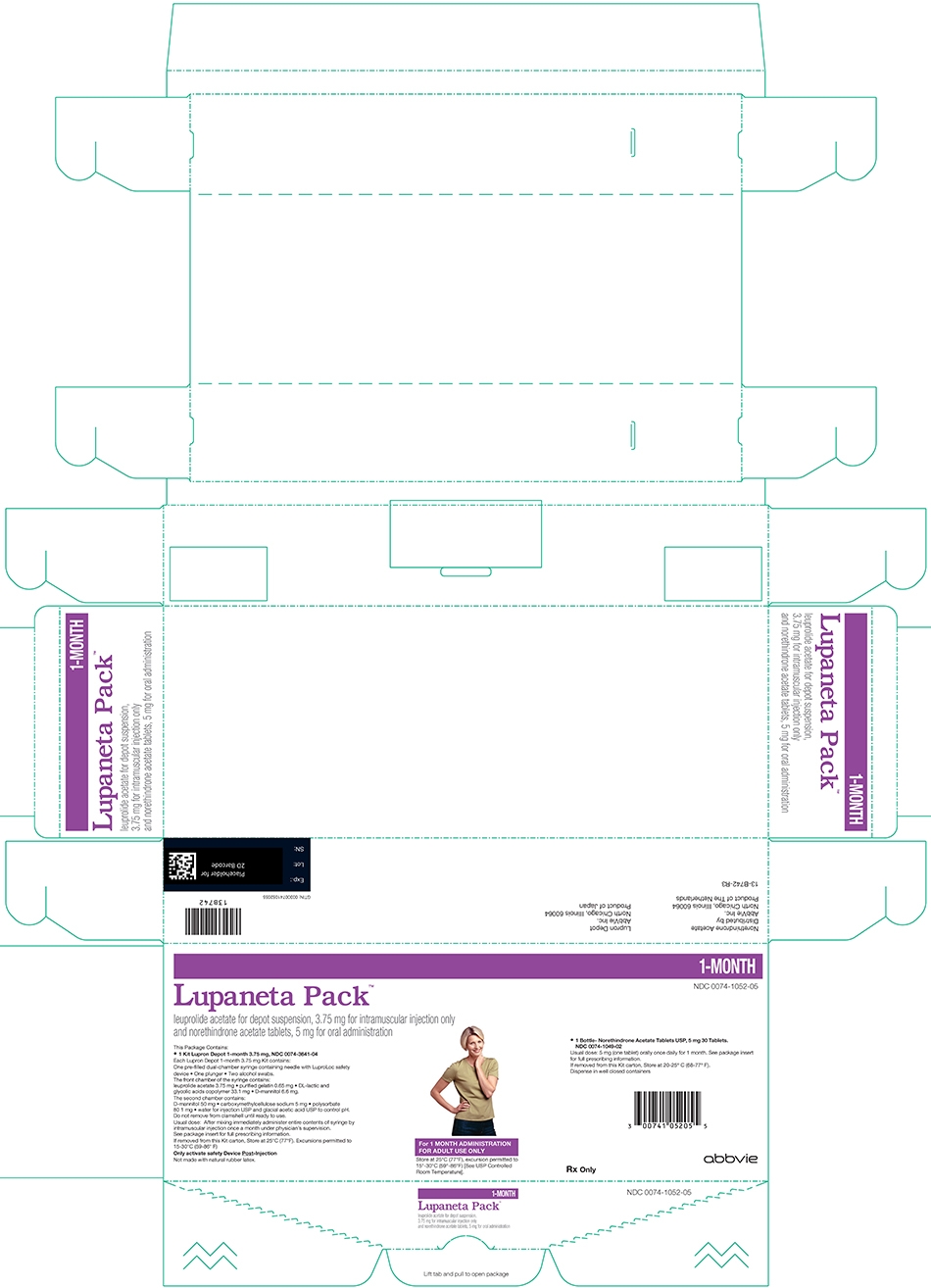
NDC: 0074-1052-10
Physician Sample - NOT for sale or billing
leuprolide acetate for depot suspension, 3.75 mg for intramuscular injection only and norethindrone acetate tablets, 5 mg for oral administration
This Physician Sample Package Contains:
1 Kit Lupron Depot 1-month 3.75 mg, NDC: 0074-3641-07
Each Lupron Depot 1-month 3.75 mg Kit contains:
One pre-filled dual-chamber syringe containing needle with LuproLoc safety device One plunger Two alcohol swabs.
The front chamber of the syringe contains:
leuprolide acetate 3.75 mg purified gelatin 0.65 mg DL-lactic and glycolic acids copolymer 33.1 mg D-mannitol 6.6 mg.
D-mannitol 50 mg carboxymethylcellulose sodium 5 mg polysorbate 80 1 mg water for injection USP and glacial acetic acid USP to control pH.
Do not remove from clamshell until ready to use.
Usual dose: After mixing immediately administer entire contents of syringe by intramuscular injection once a month under physician’s supervision.
See package insert for full prescribing information.
If removed from this Kit carton, Store at 25°C (77°F). Excursions permitted to 15-30°C (59-86°F)
Only activate safety Device Post-Injection
Not made with natural rubber latex.
1 Bottle- Norethindrone Acetate Tablets USP, 5 mg 30 Tablets. NDC: 0074-1049-30
Usual dose: 5 mg (one tablet) orally once daily for 1 month. See package insert for full prescribing information.
If removed from this Kit carton, Store at 20-25°C (68-77°F).
Dispense in well closed containers
For 1 MONTH ADMINISTRATION FOR ADULT USE ONLY
Store at 25°C (77°F), excursions permitted to 15°-30°C (59°-86°F) [See USP Controlled Room Temperature].
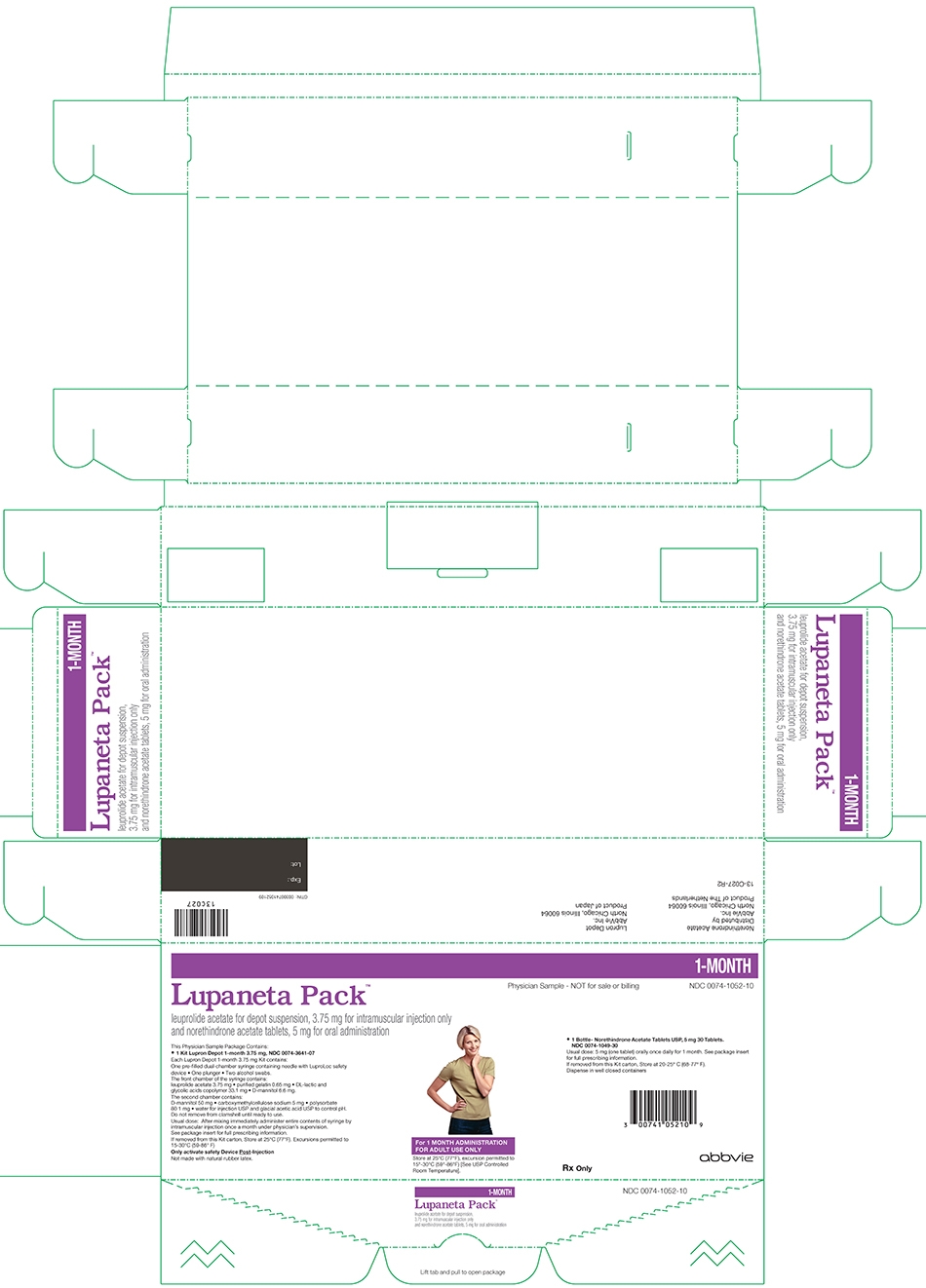
-
INGREDIENTS AND APPEARANCE
LUPANETA PACK
leuprolide acetate and norethindrone acetate kitProduct Information Product Type HUMAN PRESCRIPTION DRUG Item Code (Source) NDC: 0074-1052 Packaging # Item Code Package Description Marketing Start Date Marketing End Date 1 NDC: 0074-1052-05 1 in 1 CARTON 07/01/2013 2 NDC: 0074-1052-10 1 in 1 CARTON 07/01/2013 Quantity of Parts Part # Package Quantity Total Product Quantity Part 1 1 BOTTLE 30 Part 2 1 SYRINGE 1 mL Part 3 2 PACKET 2 mL Part 1 of 3 NORETHINDRONE ACETATE
norethindrone acetate tabletProduct Information Item Code (Source) NDC: 0074-1049 Route of Administration ORAL Active Ingredient/Active Moiety Ingredient Name Basis of Strength Strength NORETHINDRONE ACETATE (UNII: 9S44LIC7OJ) (NORETHINDRONE - UNII:T18F433X4S) NORETHINDRONE ACETATE 5 mg Product Characteristics Color WHITE (to off-white) Score 2 pieces Shape OVAL (flat faced beveled edged) Size 11mm Flavor Imprint Code G;304 Contains Packaging # Item Code Package Description Marketing Start Date Marketing End Date 1 30 in 1 BOTTLE; Type 0: Not a Combination Product Marketing Information Marketing Category Application Number or Monograph Citation Marketing Start Date Marketing End Date ANDA ANDA091090 07/01/2013 Part 2 of 3 LUPRON DEPOT
leuprolide acetate injection, powder, lyophilized, for suspensionProduct Information Route of Administration INTRAMUSCULAR Active Ingredient/Active Moiety Ingredient Name Basis of Strength Strength LEUPROLIDE ACETATE (UNII: 37JNS02E7V) (LEUPROLIDE - UNII:EFY6W0M8TG) LEUPROLIDE ACETATE 3.75 mg in 1 mL Inactive Ingredients Ingredient Name Strength ACETIC ACID (UNII: Q40Q9N063P) POLYSORBATE 80 (UNII: 6OZP39ZG8H) 1 mg in 1 mL WATER (UNII: 059QF0KO0R) MANNITOL (UNII: 3OWL53L36A) 56.6 mg in 1 mL CARBOXYMETHYLCELLULOSE SODIUM, UNSPECIFIED FORM (UNII: K679OBS311) 5 mg in 1 mL GELATIN, UNSPECIFIED (UNII: 2G86QN327L) 0.65 mg in 1 mL Packaging # Item Code Package Description Marketing Start Date Marketing End Date 1 1 mL in 1 SYRINGE; Type 2: Prefilled Drug Delivery Device/System (syringe, patch, etc.) Marketing Information Marketing Category Application Number or Monograph Citation Marketing Start Date Marketing End Date NDA NDA020011 10/22/1990 Part 3 of 3 ALCOHOL
isopropyl alcohol swabProduct Information Route of Administration TOPICAL Active Ingredient/Active Moiety Ingredient Name Basis of Strength Strength ALCOHOL (UNII: 3K9958V90M) (ALCOHOL - UNII:3K9958V90M) ALCOHOL 0.7 mL in 1 mL Inactive Ingredients Ingredient Name Strength WATER (UNII: 059QF0KO0R) Packaging # Item Code Package Description Marketing Start Date Marketing End Date 1 1 mL in 1 PACKET; Type 0: Not a Combination Product Marketing Information Marketing Category Application Number or Monograph Citation Marketing Start Date Marketing End Date OTC monograph not final part333A 07/01/2013 Marketing Information Marketing Category Application Number or Monograph Citation Marketing Start Date Marketing End Date NDA NDA203696 07/01/2013 Labeler - AbbVie Inc. (078458370)
Trademark Results [Lupaneta Pack]
Mark Image Registration | Serial | Company Trademark Application Date |
|---|---|
 LUPANETA PACK 85758707 4564941 Live/Registered |
AbbVie Endocrine Inc. 2012-10-19 |
© 2025 FDA.report
This site is not affiliated with or endorsed by the FDA.